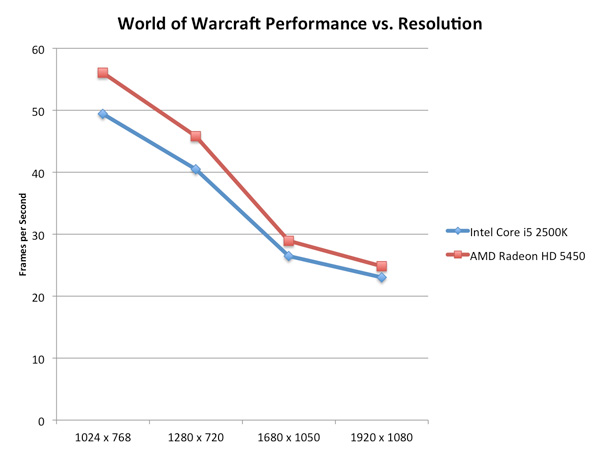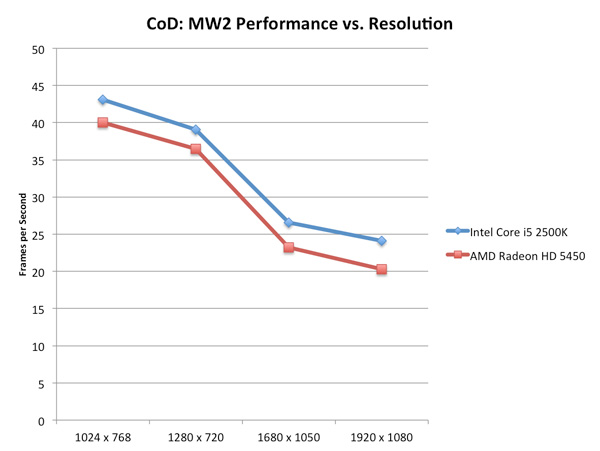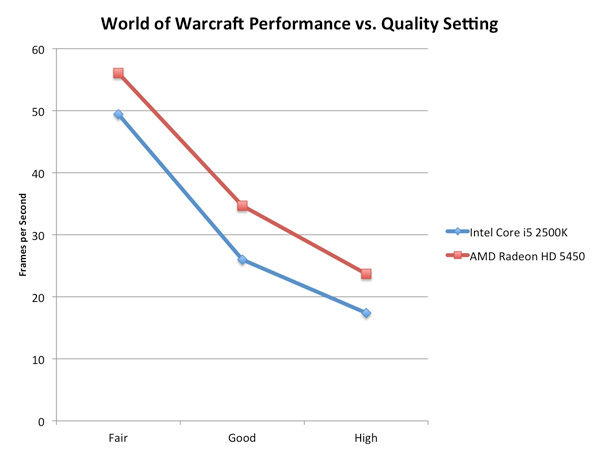The Sandy Bridge Review: Intel Core i7-2600K, i5-2500K and Core i3-2100 Tested
by Anand Lal Shimpi on January 3, 2011 12:01 AM ESTResolution Scaling with Intel HD Graphics 3000
All of our tests on the previous page were done at 1024x768, but how much of a hit do you really get when you push higher resolutions? Does the gap widen between a discrete GPU and Intel's HD Graphics as you increase resolution?
On the contrary: low-end GPUs run into memory bandwidth limitations just as quickly (if not quicker) than Intel's integrated graphics. Spend about $70 and you'll see a wider gap, but if you pit Intel's HD Graphics 3000 against a Radeon HD 5450 the two actually get closer in performance the higher the resolution is—at least in memory bandwidth bound scenarios:

Call of Duty: Modern Warfare 2 stresses compute a bit more at higher resolutions and thus the performance gap widens rather than closes:

For the most part, at low quality settings, Intel's HD Graphics 3000 scales with resolution similarly to a low-end discrete GPU.
Graphics Quality Scaling
The biggest issue with integrated and any sort of low-end graphics is that you have to run games at absurdly low quality settings to avoid dropping below smooth frame rates. The impact of going to higher quality settings is much greater on Intel's HD Graphics 3000 than on a discrete card as you can see by the chart below.

The performance gap between the two is actually its widest at WoW's "Good" quality settings. Moving beyond that however shrinks the gap a bit as the Radeon HD 5450 runs into memory bandwidth/compute bottlenecks of its own.










283 Comments
View All Comments
7Enigma - Monday, January 3, 2011 - link
Do you happen to remember the space heater.....ahem, I mean P4?DanNeely - Monday, January 3, 2011 - link
I do. Intel used bigger heatsinks than they do for mainstream parts today.panx3dx - Monday, January 3, 2011 - link
The article states that in order for quick sync to function, a display must be connected to the integrated graphics. Since p67 does not support the IGP, then quick sync will be disabled???panx3dx - Monday, January 3, 2011 - link
Opps, just saw Doormat already asked the question on page three, and I can't find a way to edit or delete my post. However no one has yet to give a clear answer.Next9 - Monday, January 3, 2011 - link
There is not any problem with BIOS and 3TB drives. Using GPT you can boot such a drive either on BIOS or UEFI based system. You should only blame Windows and their obsolete MS-DOS partitioning scheme and MS-DOS bootloader.mino - Monday, January 3, 2011 - link
Microsoft not supporting GPT on BIOS systems (hence 3TB drivers on BIOS systems) was a pure BUSINESS decision.It had nothing to do with technology which is readily available.
mino - Monday, January 3, 2011 - link
In the table there is "N" for the i3 CPUs.But in the text there is: "While _all_ SNB parts support VT-x, only three support VT-d"
Could you check it out and clarify? (there is no data on ark.intel.com yet)
mczak - Monday, January 3, 2011 - link
It's not exactly true that HD3000 has less compute performance than HD5450, at least it's not that clear cut.It has 12 EUs, and since they are 128bit wide, this would amount to "48SP" if you count like AMD. Factor in the clock difference and that's actually more cores (when running at 1300Mhz at least). Though if you only look at MAD throughput, then it is indeed less (as intel igp still can't quite do MAD, though it can do MAC).
It's a bit disappointing though to see mostly HD2000 on the desktop, with the exception of a few select parts, which is not really that much faster compared to Ironlake IGP (which isn't surprising - after all Ironlake had twice the EUs albeit at a lower clock, so the architectural improvements are still quite obvious).
DanNeely - Monday, January 3, 2011 - link
That's not true. Each AMD SP is a pipeline, the 4th one on a 69xx (or 5th on a 58xx) series card is 64 bits wide, not 32. They can't all be combined into a single 128 (160, 196) bit wide FPU.kallogan - Monday, January 3, 2011 - link
I'll wait for 22 nm. No point in upgrading for now